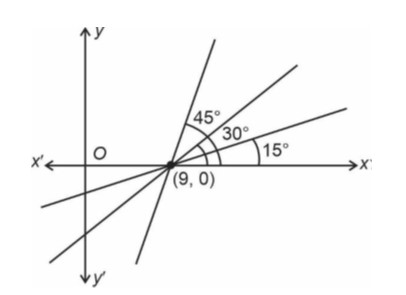55. Find the values of k for which the line (k–3) x – (4 – k2) y + k2 –7k + 6 = 0 is
(a) Parallel to the x-axis,
(b) Parallel to the y-axis,
(c) Passing through the origin.
55. Find the values of k for which the line (k–3) x – (4 – k2) y + k2 –7k + 6 = 0 is
(a) Parallel to the x-axis,
(b) Parallel to the y-axis,
(c) Passing through the origin.
-
1 Answer
-
55. We have (k - 3) x - (4 - k2) y + k2 - 7 y + 6 = 0.
(i) When the line is parall to x-axis, all x coefficient = 0. then,
(k - 3)x - (4 -k2)y + k2 - 7y + 6 = 0 x.x - a x y where a = constant
Equating the co-efficient,
K – 3 = 0
=> k = 3
(ii) When the line is parallel to y-axis all y co-efficient = 0 then
- (4 -k)2 = 0
=> – 4 + x2 = 0
k2 = 4
k = ± 2.
(iii) When the line pares through origin, (0, 0) need satisfy the given eqn then,
k2 - 7k + 6 = 0
k2 - k – 6k + 6 = 0
k (k- 1) - 6 (k - 1) = 0
(k = 1) (k - 6) = 0
k = 1 and k = 6
Similar Questions for you
Eqn : y – 0 = tan45° (x – 9) Þ y = (x – 9)
Option (B) is correct
|r1 – r2| < c1c2 < r1 + r2
->
Now,
(y – 2) = m (x – 8)
⇒ x-intercept
⇒
⇒ y-intercept
⇒ (–8m + 2)
⇒ OA + OB =
->
->
->
->Minimum = 18
Kindly consider the following figure
According to question,
Equation of required line is
Obviously B (2, 2) satisfying condition (i)
Taking an Exam? Selecting a College?
Get authentic answers from experts, students and alumni that you won't find anywhere else
Sign Up on ShikshaOn Shiksha, get access to
- 65k Colleges
- 1.2k Exams
- 679k Reviews
- 1800k Answers

